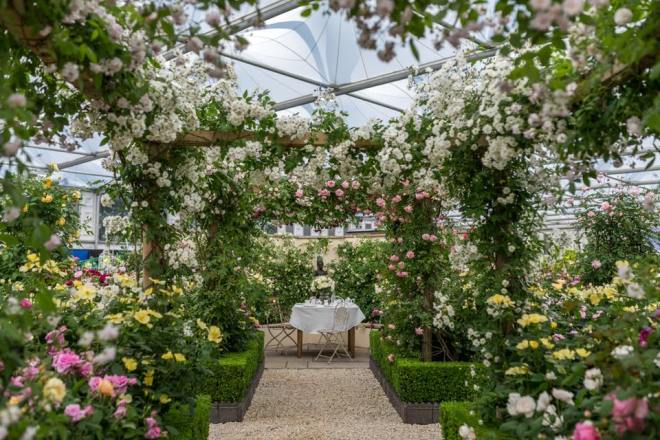One of the giants of horticulture died this week: David Austin, OBE, creator of the “English Roses.” What does this have to do with fragrance, you ask? One of Mr. Austin’s major goals in hybridizing roses was to reinstate the powerful fragrances of “old roses” into modern roses with some of the best traits of newer rose hybrids: disease resistance, repeat bloom, a wider range of colors. And he succeeded, probably even beyond his own dreams, in creating “the perfect garden worthy rose that combines beauty, fragrance, repeat-flowering ability and good disease resistance with great charm – the quality his English Roses are most renowned for.” As he wrote in his book The English Roses, he had one preeminent objective, “… that we should strive to develop the rose’s beauty in flower, growth and leaf.” Of fragrance: “[It] may be said to be the other half of the beauty of a rose”.
Mr. Austin’s English Roses won 24 gold medals at the RHS Chelsea Flower Show, the greatest flower show on earth. I’ve been privileged to visit that show twice, and the David Austin Roses display was always glorious!

David Austin Roses display at RHS Chelsea Flower Show, 2018
When he was awarded the Order of the British Empire (OBE) in 2007 for his services to horticulture, he said “Every day, I marvel at my good fortune to have been able to make a life out of breeding roses. My greatest satisfaction is to see the pleasure my roses give to gardeners and rose lovers around the world”. What a legacy to leave! Legions of lovers of the English Roses included H.M. Queen Elizabeth II, who visited his displays at Chelsea:

David Austin showing Queen Elizabeth his English Roses at Chelsea; image http://www.davidaustinroses.com.
I grow some of his roses, although I have to choose carefully which ones, as my gardening climate is more hot and humid than they prefer. But I have had some gorgeous blossoms from them, and whenever I cut a few and bring them indoors, they scent an entire room with true, beautiful rose fragrance. The company’s website says:
The English Roses are famous for the diversity and strength of their fragrances, with many varieties having won awards, both nationally and internationally, for their delicious fragrances which can be Old Rose, Tea, fruity, myrrh, musky or almost any mixture of these elements.
The website and catalog describe each rose’s fragrance in specific detail: one has a scent that is a mix of “tea, myrrh, and fruit”; another has a “strong, delicious Old Rose fragrance, often with overtones of strawberry.” There is an entire chapter in his book devoted to fragrance.
Nearly all the basic scents of the rose are to be found somewhere among English Roses and, as a rose of one scent is hybridised with a rose of another, new scent combinations become evident. So it is that we find one scent merging into another, as we move through the varieties of English Roses. I regard this as one of the greatest pleasures they have to offer us. One problem arising out of this great diversity of fragrances is the difficulty in describing them. It is rather like writing about wines; in fact, taste is, as we all know, very close to the sense of smell. We can but do our best, by means of classification and reference to other scents that most of us know. As with wines, there is the danger of sounding pretentious.
Wonderful! Mr. Austin also wrote with gratitude of benefiting from the expertise of Robert Calkin as a fragrance consultant. Mr. Calkin is the author of a classic text on perfumery, Perfumery: Practice and Principles, and apparently “a great lover of roses.” With his guidance, the English Roses are loosely grouped into these categories of fragrance: Old Rose, Tea Rose, Myrrh, Musk, Fruit, and “Myriad.” The latter prompted the following description:
Sometimes it seems as though the fragrance of all the flowers are to be found somewhere in English Roses. The scent of lilac is found in ‘Heather Austin’ and ‘Barbara Austin’; that of lily of the valley in ‘Miss Alice.’ The scent of peach blossom is found in a number of roses. Sometimes, as we cast hither and thither for a name for our fragrances, we refer to them in terms of the bouquet of wine or the fragrance of honey. Clove scent occurs in certain varieties, as, for example, in ‘Heritage’. Seldom are these comparisons exact. Not always can any two people agree on the right term, but this only adds to the many charms of English Roses.
Mr. Austin was clearly a gifted writer, and some of the tributes to him have noted his deep love of books. I’ve always been charmed by the names of the English Roses, so many drawn from English literature (“William Shakespeare”), places (“Winchester Cathedral”), history (“Fighting Temeraire”), and even horticulture (“Gertrude Jekyll”).
Online tributes are flooding in; this obituary aptly describes his contributions. I will just say that although I never had the pleasure of meeting him or being in communication with him, Mr. David Austin brought much joy to me through the beauty AND fragrance of his lovely roses. I hope that heaven had bouquets of them awaiting his arrival. May “flights of angels sing thee to thy rest,” Mr. Austin.

David Austin English Roses at Chelsea, 2018.

Pingback: RIP, David Austin – Old Herbaceous
It’s a beautiful tribute to a person who brought more joy to this world (which is something in our strange times). Thank you.
LikeLiked by 1 person
RIP David Austin. His roses were fabulous.I have bought many of his roses as gifts for special occassions.
LikeLiked by 1 person
Perhaps he will have roses for Vero. A really lovely post. ❤️
LikeLiked by 1 person
Ive always been delighted and amazed by David Austin’s beautiful roses. The world has lost another wonderful person who contributed so much.
LikeLiked by 1 person